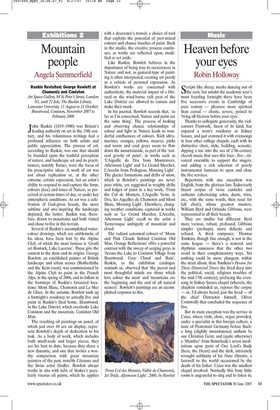Heaven before your eyes
Robin Holloway Scripts like sheep, marks dancing out of the ears; but amidst the academic year's most frazzling fortnight there have been five successive events in Cambridge of pure ecstasy — pleasure more spiritual than carnal — chaste, severe, poised to 'bring all Heaven before your eyes'.
Thanks to collegiate generosity, the violconsort Fretwork, finest of its kind, has enjoyed a term's residency at Sidney Sussex, and just crowned it with evensongs in four other college chapels, each with its distinctive choir, style, building, acoustic, dipping a toe into the sea of 17th-century church music that uses this four-, five-, sixvoiced ensemble to support the singers, and adding a rich selection of purely instrumental fantasias to open and close the five services.
Repertoire with one exception was English, from the glorious late Tudor/early Stuart corpus of verse canticles and anthems (alternating solos, duets, trios, etc., with the same words, then reset for full choir), whose greatest masters, William Byrd and Orlando Gibbons, were represented in all their beauty.
They are similar but different: Byrd more various, robust, profound; Gibbons simpler (perhaps), more delicate and refined. A third composer, Thomas Tomkins, though fine enough, is not in the same league — there's a textural and rhythmic sameness that the other two avoid in their complementary ways. Yet nothing could be more plangent, within the strait idiom, than Tomkins's Pavane for These Distracted Times (he lived deep into the political, social, religious troubles of the mid-17th century), prefacing the evensong in Sidney Sussex chapel (wherein, the chaplain reminded us, reposes the corpse — or, I'd always heard, just the head — of the chief Distractor himself, Oliver Cromwell) that concluded the sequence of five.
But its main exception was the service in Caius, where viols, choir, organ provided, under a specialist in this foreign culture, a taste of Protestant Germany before Bach: a long (slightly monotonous) anthem by one Christian Geist, and (quite otherwise) a 'Member' from Buxtehude's seven meditations upon parts of Our Lord's Body (here, the Heart) and the dark, intricately wrought sublimity of his Nunc Dimittis, a farewell to the world occasioned by the death of his father. Caius was the smallest chapel involved. Normally this boxy little room is ungrateful to sing and to listen in; somehow the particular nature of the violconsort attuned with the well-compacted voices to turn low ceiling and tight acoustic to maximum advantage.
Sidney, too, had something of this chamber-music character, but — longer, narrower, higher — the sound was less intimate, tending (abetted by a choir containing more mature male voices than the entirely student forces elsewhere) towards a slight oppressiveness even in its very grandeur. The other three chapels were all large, and King's, the most celebrated, is enormous. All solved the balance problems differently and successfully.
In King's, one can be forgiven for diffusing the experience into a synaesthesia of light, space, sound: wood, stone, glass; men/boys/viols; Gibbons at his supreme in See, the Word is Incarnate. Trinity with no comparable architectural splendour yielded a clearer sonority (here, the two Gibbons masterpieces were This Is the Record of John and Behold, Thou Hast Made My Days): while at St. John's the unforgiven brute of a Victorian chapel afforded the best sound of all. Here, however, I'd managed to get right down to floor-level, as closely entangled as permissible with players and singers, to relish the sound built up layer by layer to combine in the long, tall, narrow space. The musical rewards at this service were twofold: a relatively unknown Gibbons anthem, We Praise Thee Father (possibly its first liturgical outing in modern times — newly published in Fretwork's own edition, practical aid, as their performances are practical incentive, to wider dissemination); and two six-part fantasias at the start which touched heights and depths worthy of the late Beethoven quartets.
Incidental interest, less exalted but just as piquant, was provided by the five choirmasters' idiosyncrasies and the demeanour of their choral forces — the jolly little goodbye waves whereby the John's-man 'leavened' the texture when it threatened to thicken; the beatific beam on the King's-man's face which probably achieved the same end; the manic pumping and heaving, more suited to Mahler, of the Trinity-man, who also appeared to conduct the movements of congregation, even clergy, like a control-freak puppeteer.
These and plenty of further visual and aural amusements were of course subsumed in the profound joy yielded by these five occasions. Such repertory is utterly distinct from later church music. Its eschewal of rhetoric, pathos, word-painting, is 'inexpressive', like the angels in Milton's Hymn on the Morning of Christ's Nativity, rather than the deliberated impersonal anti-expressiveness of the 20th century. The German branch, serious, weightier, squarer in rhythm, harmonically more directed, foretells the way things will evolve: the English — airy and transparent, light-filled and dancing, chaste and delicate — was lost for ever when the brilliant, sprightly violins overtook, and took over.



















































































 Previous page
Previous page